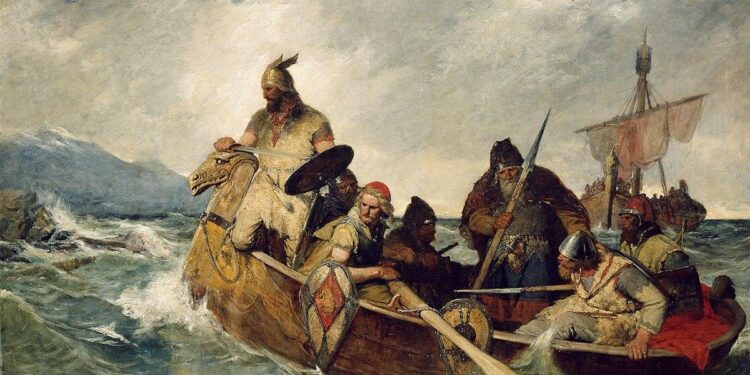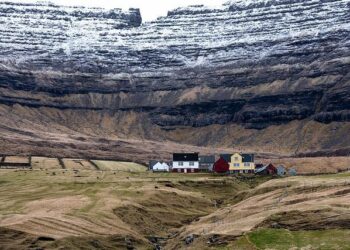New genetic research has shed fresh light on the origins of Viking settlers in the North Atlantic, revealing distinct ancestral patterns between the populations of the Faroe Islands and Iceland. Published recently on Phys.org, the study leverages advanced DNA analysis to trace the unique migration and settlement histories of these remote island communities. The findings not only deepen our understanding of Viking expansion but also highlight the diverse genetic legacies left by Norse explorers across the Atlantic.
Genetic Analysis Reveals Separate Viking Origins for Faroe Islands and Iceland Settlers
Recent advances in genomic sequencing have uncovered compelling evidence that the Norse settlers who colonized the Faroe Islands and Iceland did not originate from a single homogenous Viking population. Instead, researchers have identified distinct genetic lineages pointing to separate migration waves and origins within Scandinavia. This discovery challenges previous assumptions that these island groups were settled by a uniform Viking diaspora, revealing a more complex pattern of seafaring and settlement in the North Atlantic during the Viking Age.
The study highlights several key differences in the genetic makeup of populations from the two islands, including variations in mitochondrial DNA and Y-chromosome markers. Some of the main distinctions include:
- Faroe Islands: Stronger genetic ties to Western Norway and parts of the British Isles.
- Iceland: A blend of Eastern Norwegian ancestry and unique genetic markers linked to the British Isles.
These findings underscore how Viking migrations were influenced by diverse factors such as trade routes, maritime technology, and local environmental conditions. Below is a simplified overview of the genetic differentiation between Faroe and Iceland settlers:
| Genetic Feature | Faroe Islands | Iceland |
|---|---|---|
| Primary Origin | Western Norway | Eastern Norway |
| Mitochondrial DNA | High British Isles influence | Mixed Scandinavian & British Isles |
| Y-Chromosome Markers | Distinct Scandinavian haplogroups | Unique Norse-British haplotypes |
Distinct Ancestral Lineages Shed Light on Migration Patterns Across the North Atlantic
Recent genetic analyses reveal that the early Norse settlers of the Faroe Islands and Iceland originated from distinct ancestral lineages, challenging the previously held view of a uniform Viking expansion throughout the North Atlantic. While both island populations share Scandinavian roots, their genetic signatures exhibit notable differences that suggest separate migration waves or source communities. These findings underscore the complexity of Viking mobility and settlement strategies, highlighting localized interactions with indigenous populations and diverse homelands within Scandinavia.
The comparison of mitochondrial DNA and Y-chromosome markers indicates varying degrees of female and male contributions to each island’s gene pool. Key discoveries include:
- Faroe Islands: Greater Scandinavian male lineage dominance accompanied by a significant Iberian female genetic input.
- Iceland: More balanced contributions from Norse men and women, with less evidence of external maternal ancestry.
| Feature | Faroe Islands | Iceland |
|---|---|---|
| Male Viking Lineage (%) | 85% | 78% |
| Female Iberian Ancestry (%) | 28% | 12% |
| Overall Scandinavian Origin | High | High |
Experts Recommend Integrating Genetic Data with Archaeological Research for Comprehensive Viking History
Recent breakthroughs in genetic analysis have illuminated the nuanced origins of Viking settlers who colonized the Faroe Islands and Iceland. While traditional archaeological methods have long provided a window into Viking artifacts and settlement patterns, experts emphasize that integrating genetic data enriches the historical narrative by revealing distinct ancestral lineages. This multidisciplinary approach has uncovered that, contrary to earlier assumptions of a homogenous Viking migration, separate groups with unique genetic signatures contributed to each island’s population, suggesting varied migration routes and interactions with indigenous communities.
Specialists advocate for a combined methodology that leverages both genetic sequencing and archaeological findings to construct a more comprehensive Viking history. Key advantages of this integrated research include:
- Refined chronology: Aligning genetic timelines with material culture artifacts for accurate dating.
- Population diversity: Identifying distinct settler origins and demographic shifts.
- Cultural exchanges: Tracing interactions between Viking groups and native populations through shared genetic markers.
- Migration patterns: Detecting separate settlement waves and discovering new migration routes.
| Region | Primary Genetic Lineage | Estimated Settlement Period | Notable Archaeological Finds |
|---|---|---|---|
| Faroe Islands | Western Scandinavian Haplogroup I1 | 9th – 10th Century | Longhouse Remains, Iron Tools |
| Iceland | Eastern Scandinavian Haplogroup R1a | 870 – 930 AD | Viking Burial Sites, Norse Script Stones |
Closing Remarks
As genetic research continues to unveil the intricate histories of human migration, the latest findings shed new light on the origins of Viking settlers in the North Atlantic. By distinguishing the genetic signatures of those who colonized the Faroe Islands and Iceland, scientists are piecing together a more nuanced understanding of Viking expansion and settlement patterns. These insights not only enrich the historical narrative of the Norse world but also demonstrate the power of modern genetics to illuminate the movements and interactions of ancient peoples. Further studies promise to deepen our grasp of how these island communities evolved, preserving their unique cultural and genetic legacies across centuries.
















